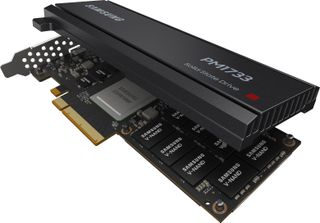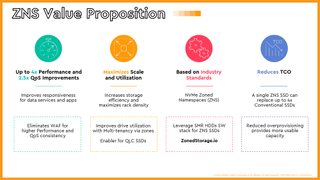Samsung and Western Digital Team Up for ZNS SSDs
The two storage companies will jointly develop and promote zoned storage technologies.

Zoned namespaces (ZNS) storage technologies promise to significantly improve the performance and reliability of next-generation solid-state drives and hard disk drives, but ZNS adoption requires significant efforts from device markers and data center operators alike. To simplify the development of next-generation ZNS HDDs and SSDs, Samsung and Western Digital on Tuesday inked a memorandum of understanding (MOU) to jointly standardize and develop zoned storage technologies.
Both Samsung and Western Digital have announced their respective ZNS SSDs in recent years, but these drives have not been adopted widely so far perhaps because they are implemented differently, and therefore behave differently. Furthermore, a smoothly interoperable ecosystem of ZNS storage technologies is still not quite there, so deploying appropriate drives is not easy. To make matters even more complicated, ZNS drives are not widely available from various vendors, so buying a ZNS SSD from one maker essentially means an exclusive supply agreement.

ZNS SSDs offer numerous benefits over conventional block-based drives. Firstly, they place data sequentially into zones and have better control over write amplification, since the software understands what it is dealing with. As a result, ZNS SSDs do not need to assign as much 3D NAND for overprovisioning as traditional enterprise drives do these days, which ultimately leads to lower costs and power consumption. Furthermore, this simplifies using new NAND architectures, like QLC 3D NAND.
Secondly, since ZNS manages large zones rather than a plethora of 4KB blocks and does not have to perform garbage collection as often as traditional SSDs, they have faster real-world read and write performance. For the same reason, it is easier to manage shingled magnetic recording (SMR) hard drives in a ZNS software environment, which is another benefit.

But software has indeed obstructed the adoption of ZNS. Both Samsung and Western Digital have participated in ZNS software development, but it looks like the two companies now want to try developing an ecosystem that will involve fewer participants but will guarantee timely availability of software and hardware that is interoperable and works predictably.
Under the terms of the MOU, Samsung and Western Digital will jointly standardize and drive the adoption of next-generation data placement, processing, and fabrics (D2PF) storage technologies. The two companies will define high-level models and frameworks for next-generation Zoned Storage technologies as well as open and scalable data center architectures. Back in December 2021, Samsung and Western Digital formed Zoned Storage TWG (Technical Work Group), which is shaping and specifying use cases for Zoned Storage devices, as well as host/device architecture and programming models.
"Our collaborative efforts will embrace hardware and software ecosystems to ensure that as many customers as possible can reap the benefits of this highly important technology," said Jinman Han, Corporate EVP, Head of Memory Sales & Marketing at Samsung Electronics.
"For years Western Digital has been laying the foundation for the Zoned Storage ecosystem by contributing to the Linux kernel and open-source software community," said Rob Soderbery, EVP and GM, Flash Business Unit at Western Digital. "We are excited to bring these contributions to this joint initiative with Samsung in facilitating wider adoption of Zoned Storage for users and application developers."
Stay On the Cutting Edge: Get the Tom's Hardware Newsletter
Get Tom's Hardware's best news and in-depth reviews, straight to your inbox.

Anton Shilov is a Freelance News Writer at Tom’s Hardware US. Over the past couple of decades, he has covered everything from CPUs and GPUs to supercomputers and from modern process technologies and latest fab tools to high-tech industry trends.
Most Popular



